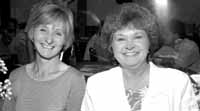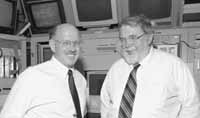 |
|
Users Face a Paradox by Kurt Riesselmann
"There is a truly spectacular discovery potential and excitement in high energy physics, met by unprecedented prosperity and public support for science," he said. "Yet the path ahead is unclear. There is a downward pressure on physics budgets." In his address to users at the June 26-27 meeting, Fermilab's Director Michael Witherell concurred. He summarized the central physics issues of current interest to the worldwide HEP community; topics that could revolutionize the current scientific understanding of the origins of the universe and lead to major changes in the Standard Model of particle physics.
Finding a vision
"We are significantly under-funded given the exciting prospects," said Dorfan. "Maybe it's time for a new way of planning. Ideally, we should be planning on a global basis. We should develop a long range roadmap, a 30-year vision." To help create that vision, physicists are planning Snowmass 2001, a field-wide meeting to be held in Colorado next summer. Its goal is to help the high-energy physics community converge on a path to the future. Snowmass organizer, Fermilab theorist Chris Quigg, spoke to users about its aims. "Snowmass participants will undertake a thematic survey of our vision of particle physics and its future. We expect about 500 physicists, and we encourage international participation," he said. Quigg also expects conferees to connect with the public. "No person coming through the Roaring Fork Valley during Summer 2001 should leave without learning what particle physics is all about." Dorfan also called for increased collaboration and emphasized to users the importance of "greater involvement of the university community in developing the tools of the future."
Tough choices
"The best bet is to make a major discovery in the next few years. This would increase the excitement in the field," said John Womersley, spokesman of DZero. "During Run II we have the great chance of finding the Higgs particle. The Directorate has to ensure that we put enough resources into this." Womersley and collaborators hope that Fermilab can increase the number of collisions produced in Run II to a total of 30 inverse femtobarns, allowing for the possible discovery of a Higgs particle as heavy as 180 GeV. Witherell assured users that the collider experi-ments have the highest priority. "We will be giving special attention to the Run IIb luminosity upgrades over the next few years to help CDF and DZero to look for as heavy a Higgs as possible," he said. If the two experiments detect signs of new physics, then other accelerator-based experiments, including the just-approved BTeV experiment (see story on page 8), will need to stand back. Witherell and Fred Bernthal, president of Universities Research Association, stressed the importance of the readiness of CDF and DZero detectors to begin data taking when Collider Run II starts in March 2000. Right now both experiments are on track.
"In high-energy physics our attentions are always divided between the intensity of the present and the challenge of the future. We need many opportunities to talk together, formally and informally, about the issues facing the field. The Users' Meeting is one big formal place to pull it all together." |
| last modified 7/21/2000 email Fermilab |
FRLsDFx9eyfrPXgV
 Joe Dehmer said it all: The high-energy physics community faces "the best of times and the worst of times." Addressing the Fermilab Users' Annual Meeting last month, Dehmer, director of National Science Foundation's Physics Division, called it the "HEP paradox."
Joe Dehmer said it all: The high-energy physics community faces "the best of times and the worst of times." Addressing the Fermilab Users' Annual Meeting last month, Dehmer, director of National Science Foundation's Physics Division, called it the "HEP paradox."
 "Fermilab's research program is addressing all of these important issues with experiments that are the best or among the best in the world," Witherell said. "During Collider Run II, to start in early 2001, there is a good chance for very important discoveries. But our current funding level is not sufficient to take advantage of all the scientific opportunities."
"Fermilab's research program is addressing all of these important issues with experiments that are the best or among the best in the world," Witherell said. "During Collider Run II, to start in early 2001, there is a good chance for very important discoveries. But our current funding level is not sufficient to take advantage of all the scientific opportunities."

 At the meeting's end, Users' Executive Committee Chair Dan Amidei summarized:
At the meeting's end, Users' Executive Committee Chair Dan Amidei summarized: